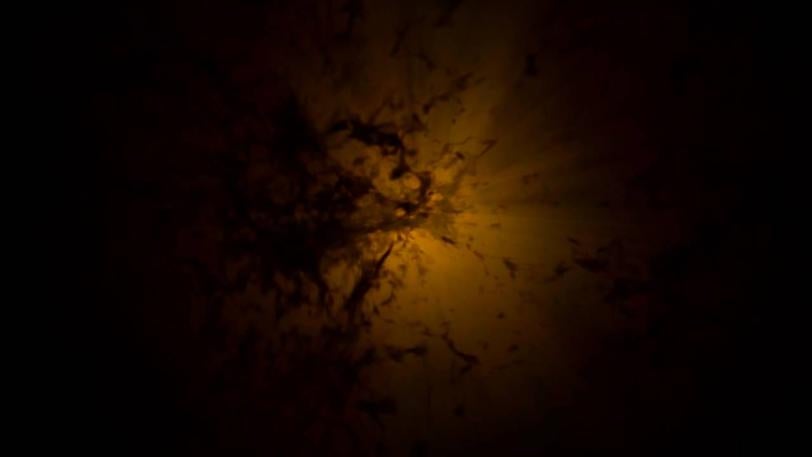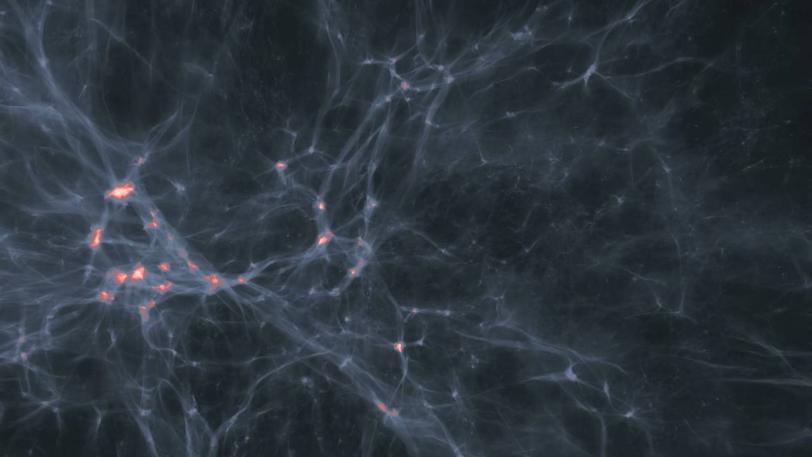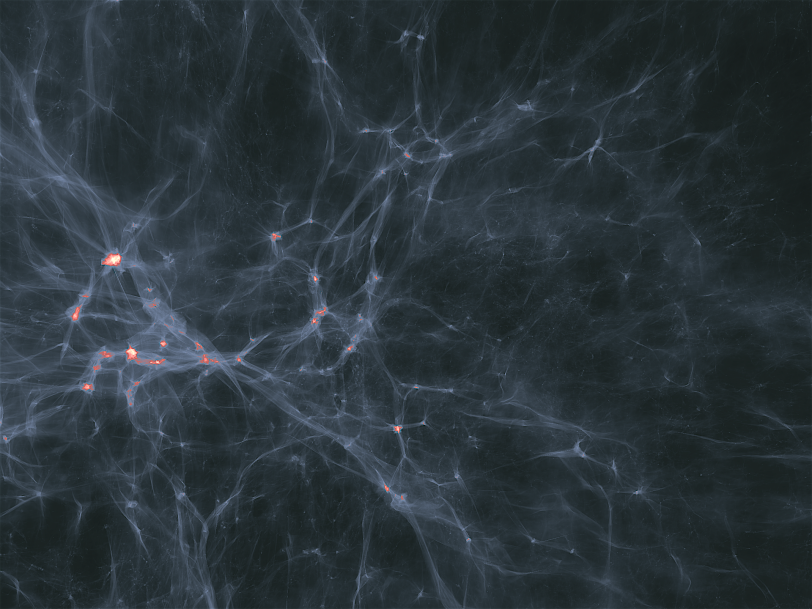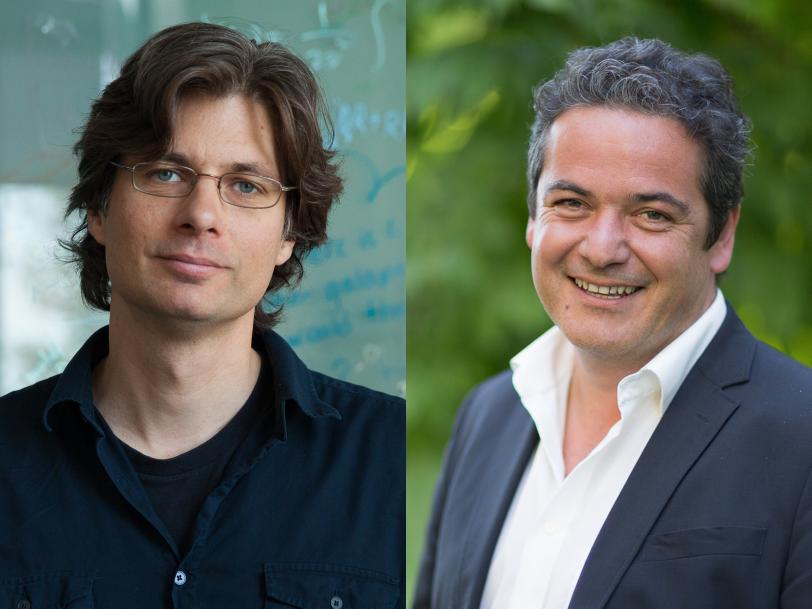Q&A: SLAC Cosmology Research Featured in Terrence Malick’s ‘Voyage of Time’
KIPAC’s Ralf Kaehler and Tom Abel Contributed Two Scenes to the Science Documentary Narrated by Brad Pitt and Cate Blanchett
Attention, movie and science enthusiasts: Get the popcorn ready because Hollywood has created a brand new adventure for you! The science documentary “Voyage of Time,” written and directed by Terrence Malick, invites you to go on a fascinating journey through the history of the cosmos via awe-inspiring images and visual effects.
The movie’s 40-minute, giant-screen version, narrated by Brad Pitt, is coming to IMAX theaters today. A 90-minute, regular version, narrated by Cate Blanchett, premiered at the 2016 Venice Film Festival and will hit the box offices at a later date.
Both versions feature two scenes contributed by visualization expert Ralf Kaehler and astrophysicist Tom Abel from the Kavli Institute for Particle Astrophysics and Cosmology (KIPAC), a joint institute of Stanford University and the Department of Energy’s SLAC National Accelerator Laboratory.

Voyage of Time IMAX® Trailer
Telling the story of the universe is a project that has been long in the making for Malick, who directed movies such as “Badlands” (1973), “The Thin Red Line” (1998) and “The Tree of Life” (2011).
According to the film’s production notes, “Throughout much of his life, long prior to beginning production on this film, Malick was immersing himself in studies astronomical, biological and philosophical, compiling notes and talking to professors, researchers and innovators in fast-moving fields ranging from physics to anthropology. The preparation led up to a film that had to carve out a new form from the intersections of science and art.”
For the “Voyage of Time,” Malick’s team consulted with leading scientists in a number of fields, including physics, biology and natural history. Kaehler and KIPAC Director Abel lent their expertise in modeling the evolution of our ever-changing universe. They collaborated with Dan Glass, the film’s visual effects supervisor and associate producer, who is known for his work on “The Matrix Reloaded” (2003) and “Batman Begins” (2005).
In this Q&A, the KIPAC researchers talk about their contributions and share the excitement that comes with a large Hollywood production.
What is “Voyage of Time?”
Kaehler: It’s a documentary about the whole history of our universe, starting with the Big Bang and going all the way to the evolution of human beings and far beyond. The film’s imagery is based on state-of-the-art scientific data, our best knowledge of how cosmic history might have unfolded. The sheer size and high resolution of IMAX screens will show fascinating special effects in subtle detail, so it should be a very special experience.

Voyage of Time: First Stars
What exactly did you contribute?
Kaehler: We contributed two scenes that are included in both versions of the movie, the IMAX version and the longer cut with lower resolution. The first scene shows the formation of the very first stars that lit up our universe. The second one shows how dark matter evolved in the universe and clumped together, triggering the formation of large-scale structures such as galaxies and galaxy clusters. Both scenes are visualizations based on computer simulations that we had previously done at KIPAC.
Abel: You have to make many creative choices when turning visualizations of scientific data into something you want to show on a theater screen. What parts of the visualization do you highlight? What camera angles do you choose? How is the camera moving and how fast? What colors do you use? How do you best create 3-D impressions on a 2-D screen? We worked closely with Dan Glass on the choreography so that it would match Terrence Malick’s vision of the movie.

Voyage of Time: Dark Matter
What was most exciting about this experience?
Kaehler: I’m very excited that we got the chance to contribute something to a documentary of this scale that will communicate science to such a large audience. And of course we really enjoyed working with these world-renowned filmmakers, whose work we admire so much.
Abel: Contributing to a real feature film also added a new layer to our work. At KIPAC, we already have a lot of experience with outreach work. We made shows for Hayden Planetarium in New York and Morrison Planetarium in San Francisco, contributed to TV shows, such as “Through the Wormhole,” and worked with a number of magazines, including National Geographic. But none of these projects had the dimension of a Hollywood production.
How did you get involved in the project?
Abel: Dan contacted us because he had seen our work on planetarium shows. He roughly explained the idea for “Voyage of Time” and asked us if we were interested in collaborating and helping out with this ambitious project.
Kaehler: We then made suggestions for our scenes. During a number of telephone conferences we would gradually refine rendering parameters like color mapping and camera motions until we converged on the final visuals. We worked on this on and off over a period of maybe six to eight months.
Have you seen the film yet?
Abel: We’ve seen our final scenes, and the trailers and featurettes that are available online. But we haven’t seen the full production yet. We’re very much looking forward to seeing it on the big screen.

IMAX® Presents: Voyage of Time
For showtimes check the IMAX website.
For questions or comments, contact the SLAC Office of Communications at communications@slac.stanford.edu.
SLAC is a multi-program laboratory exploring frontier questions in photon science, astrophysics, particle physics and accelerator research. Located in Menlo Park, Calif., SLAC is operated by Stanford University for the U.S. Department of Energy's Office of Science.
SLAC National Accelerator Laboratory is supported by the Office of Science of the U.S. Department of Energy. The Office of Science is the single largest supporter of basic research in the physical sciences in the United States, and is working to address some of the most pressing challenges of our time. For more information, please visit science.energy.gov.









